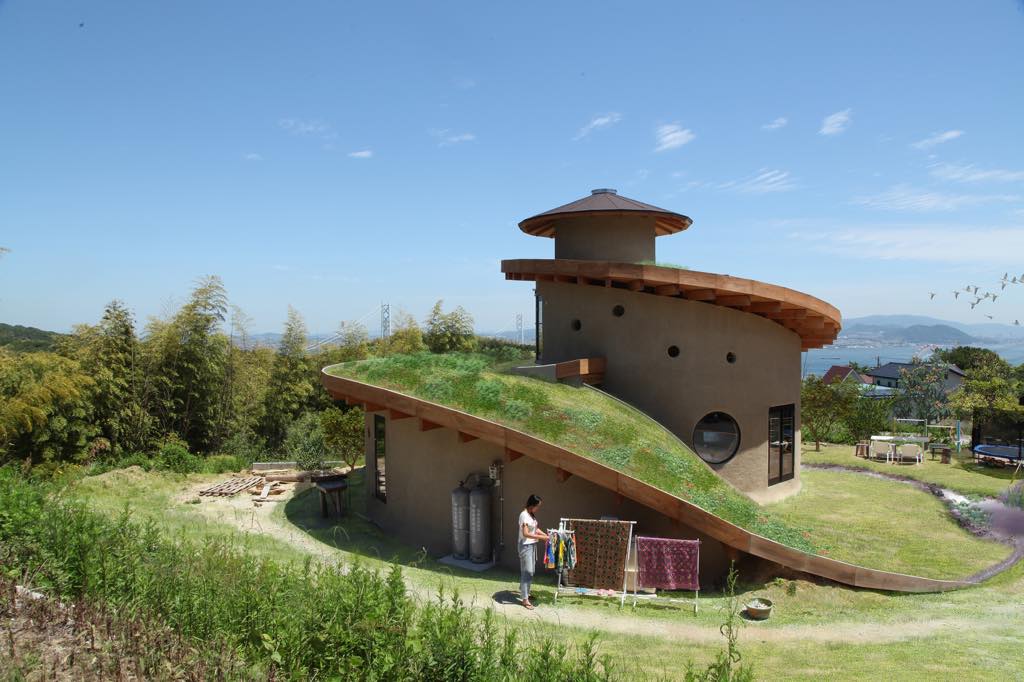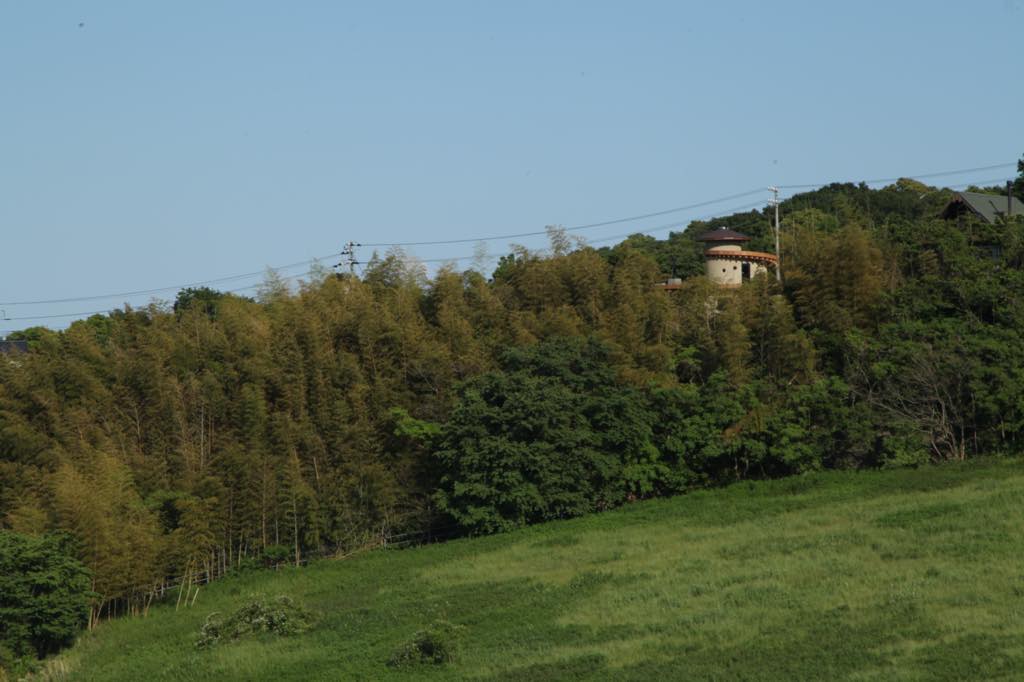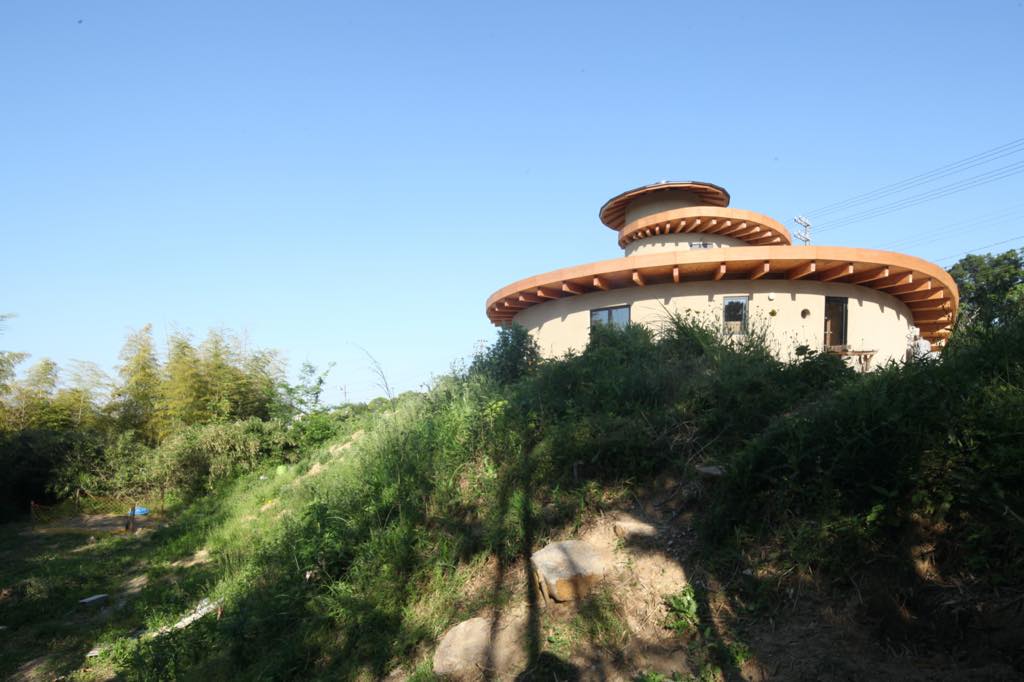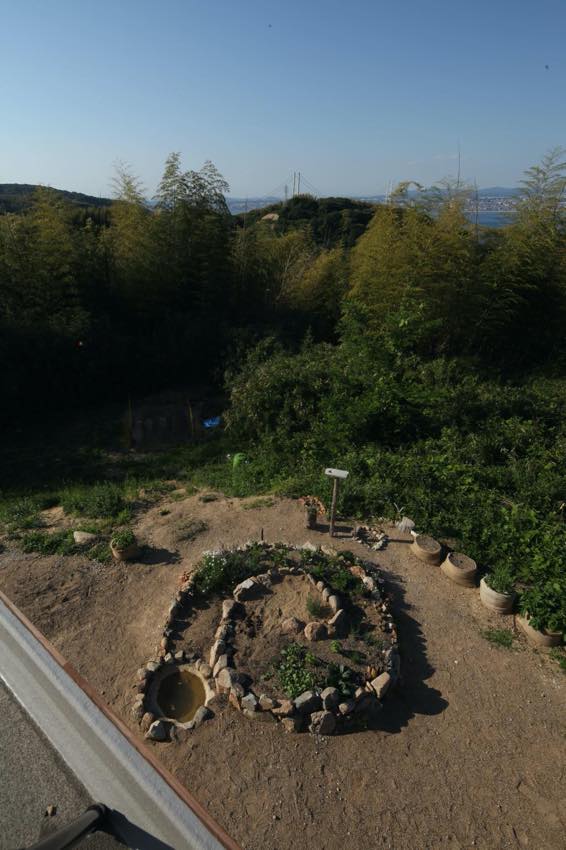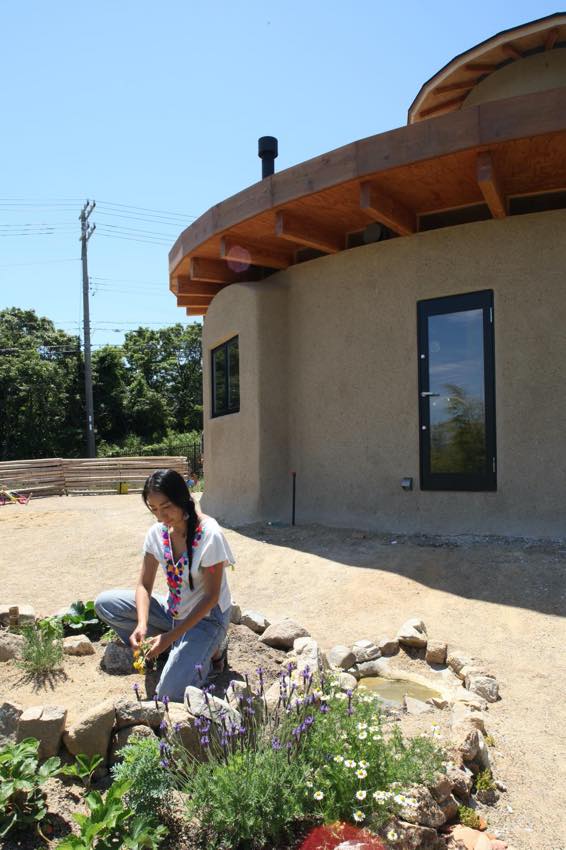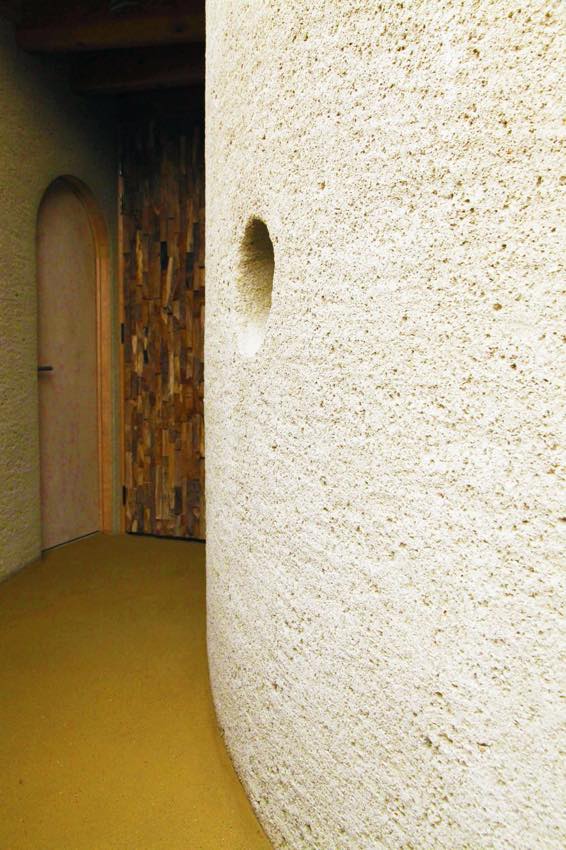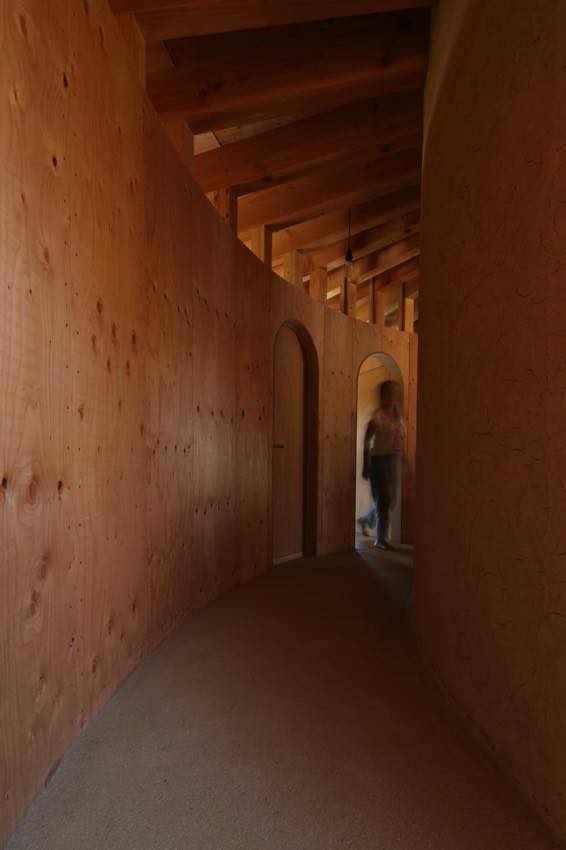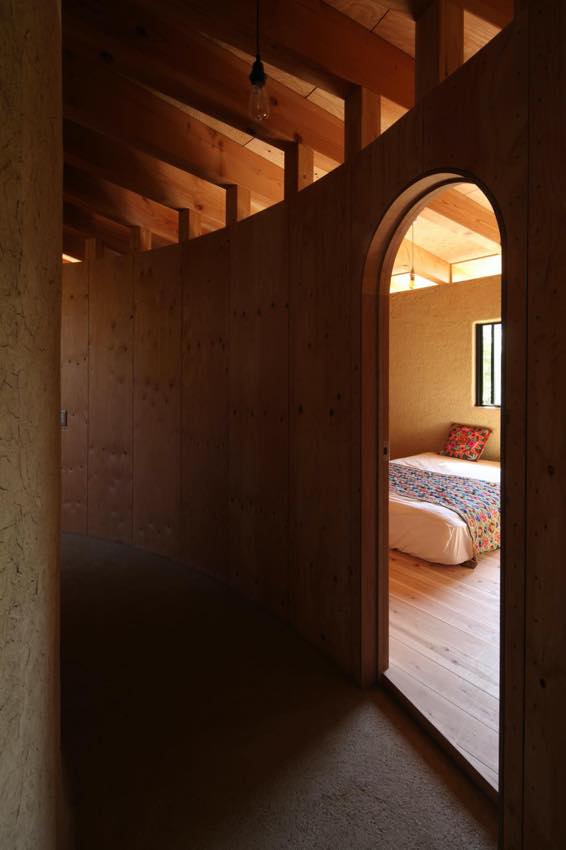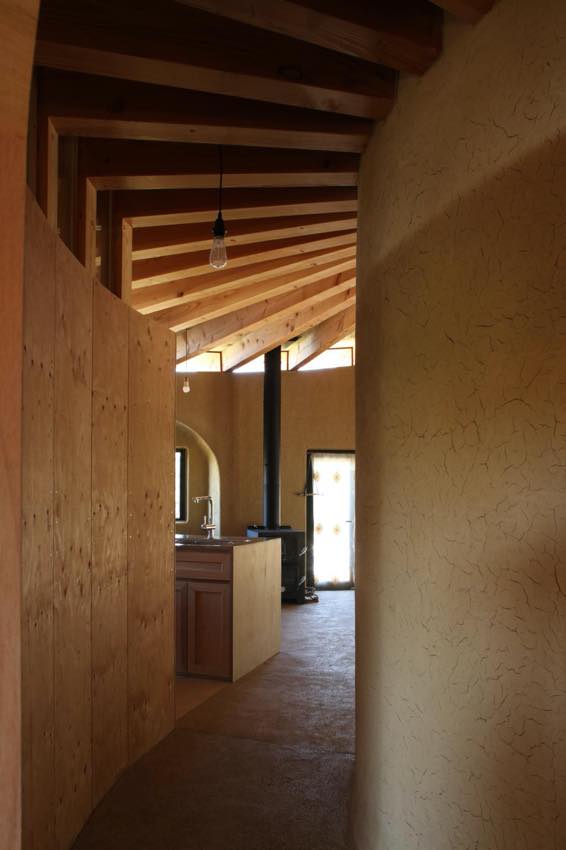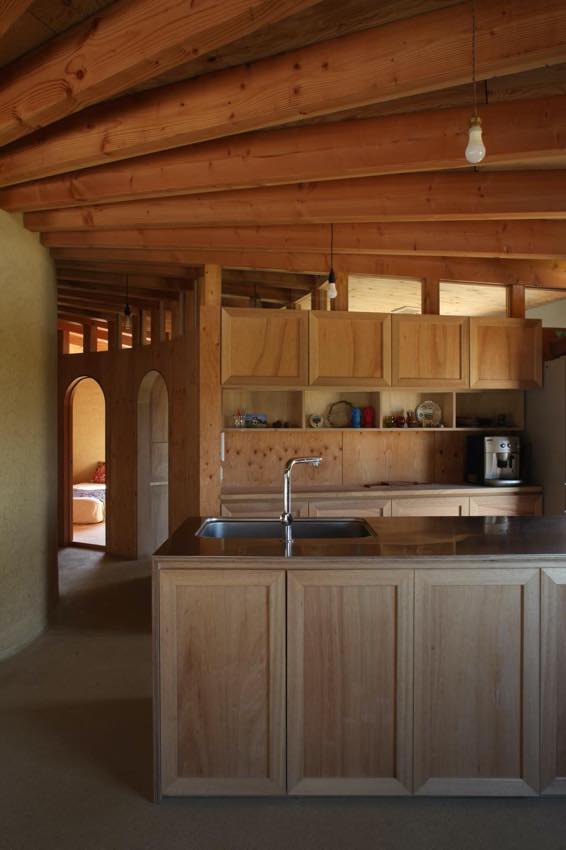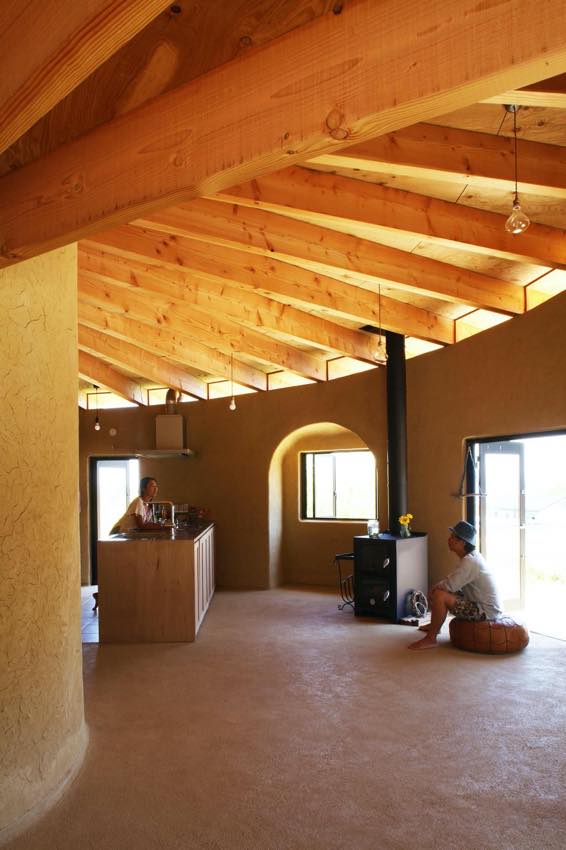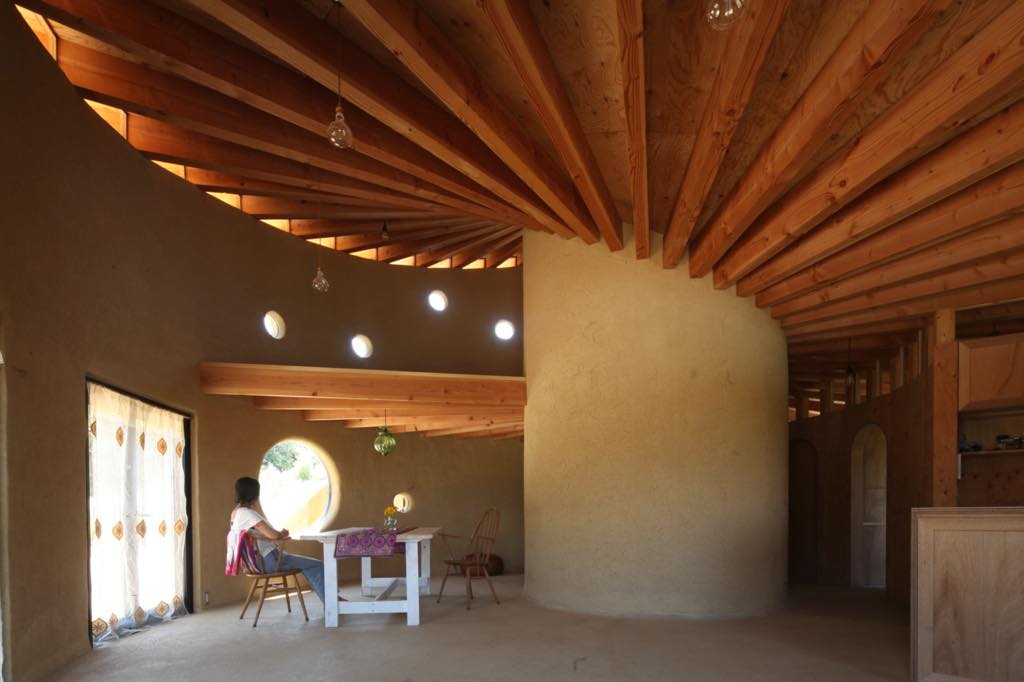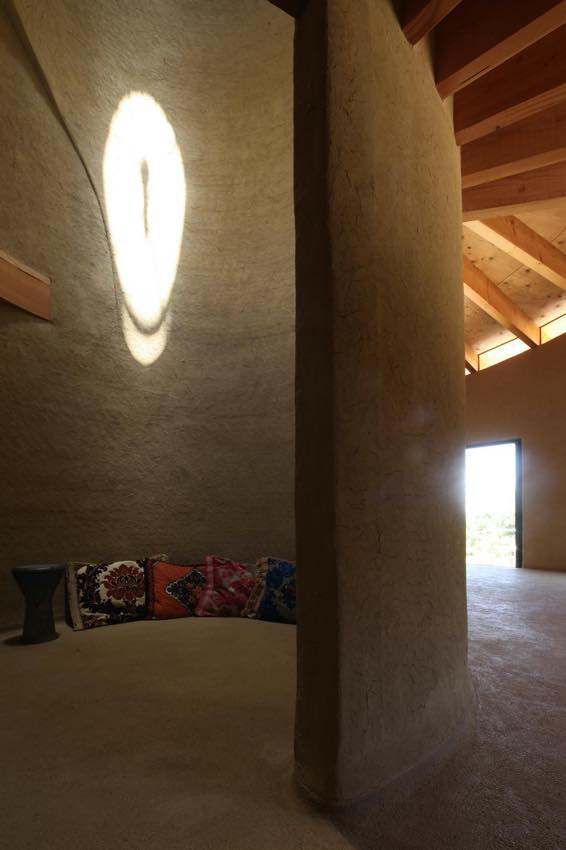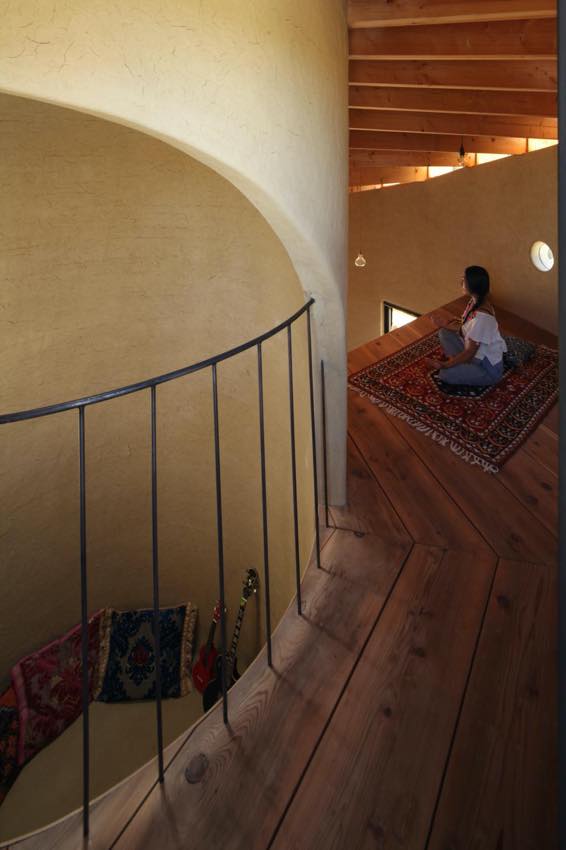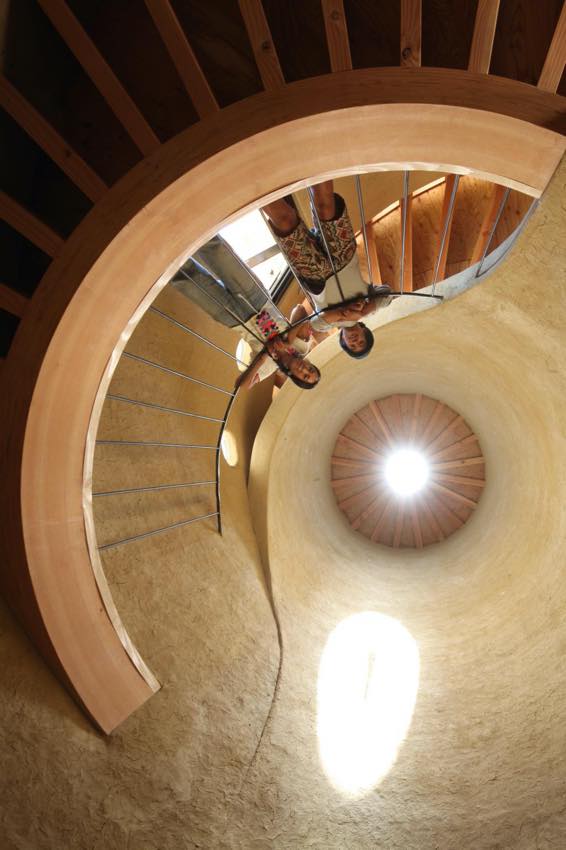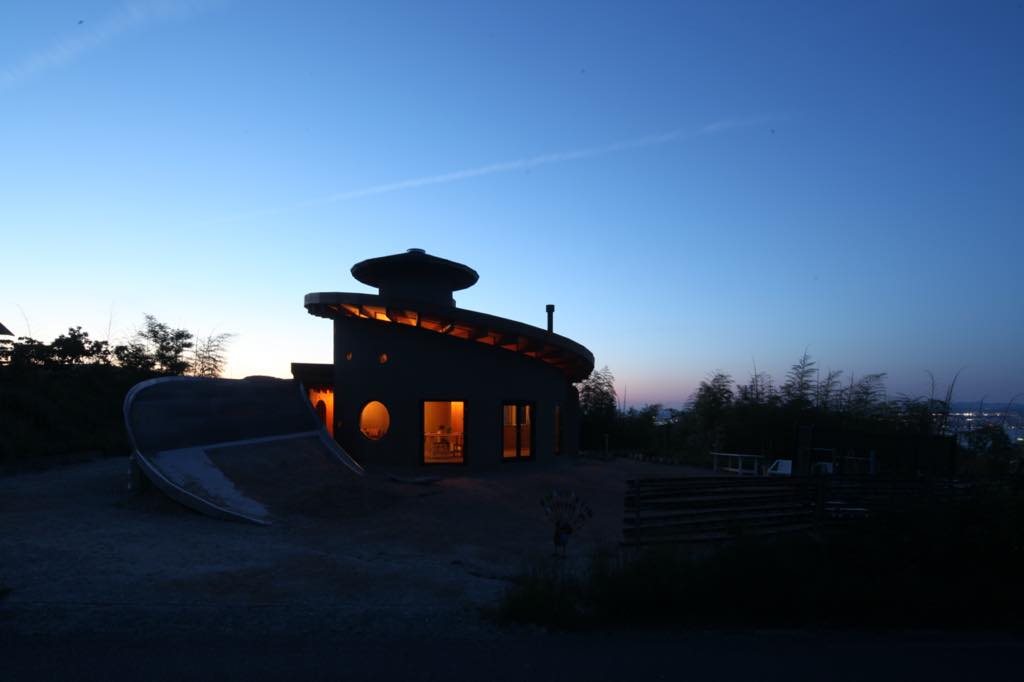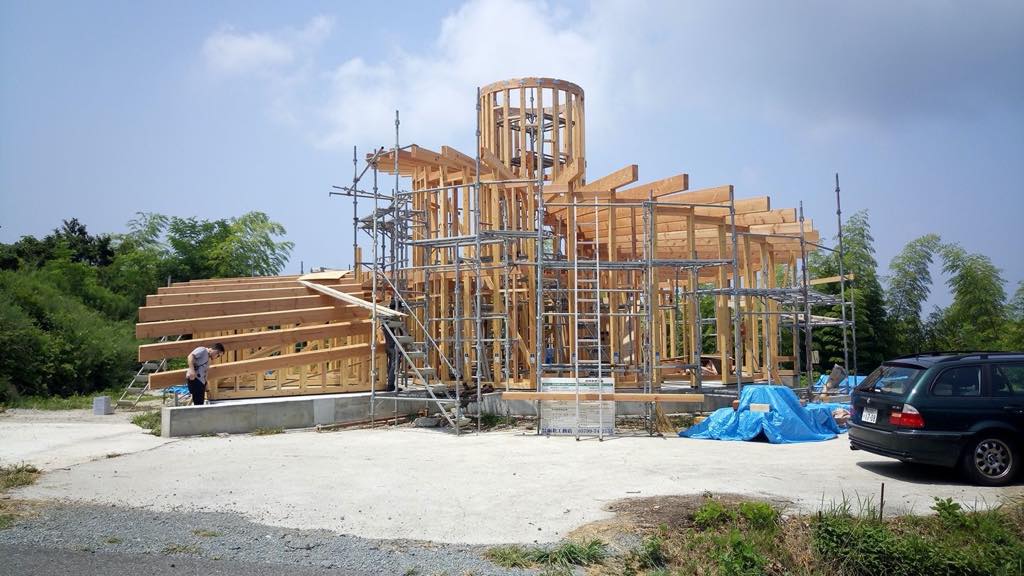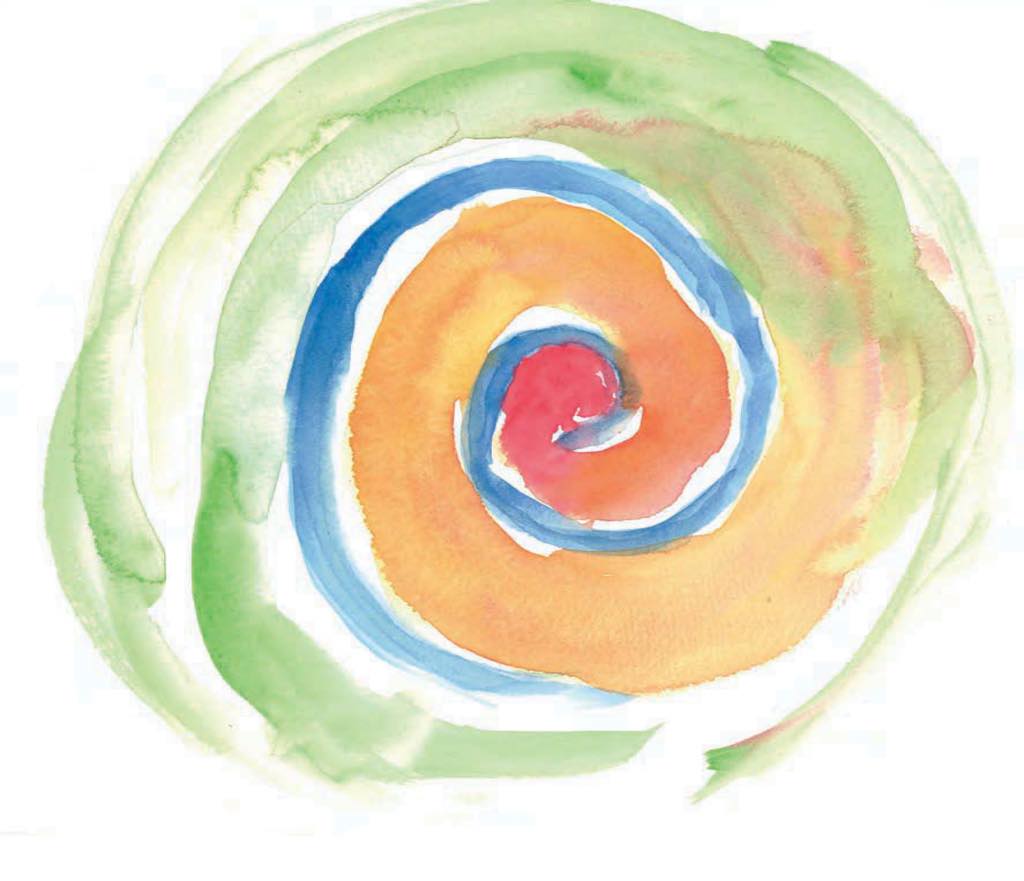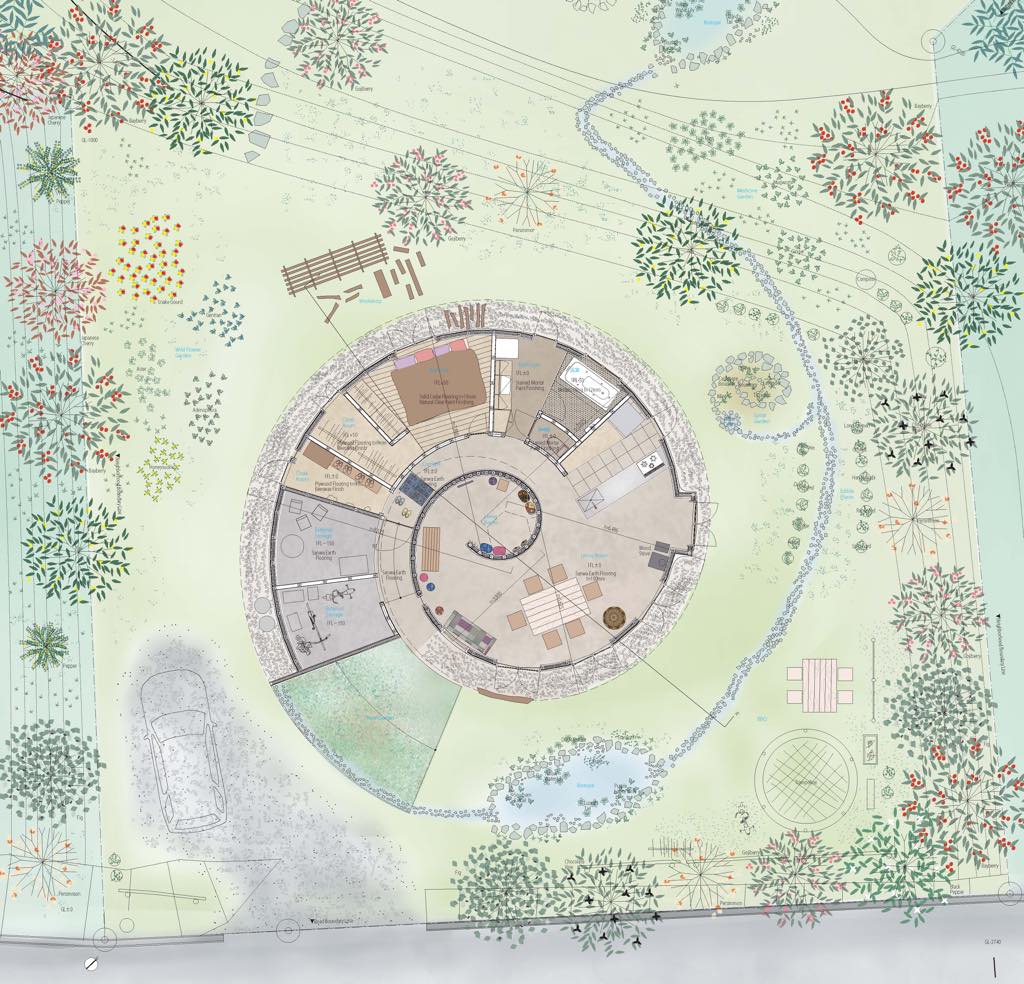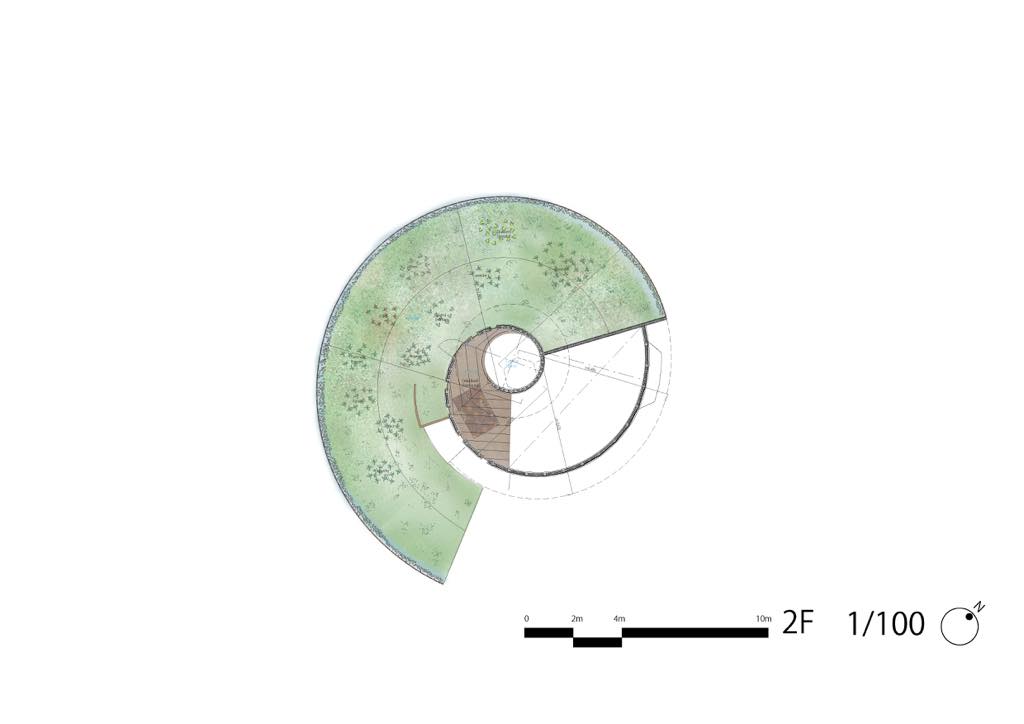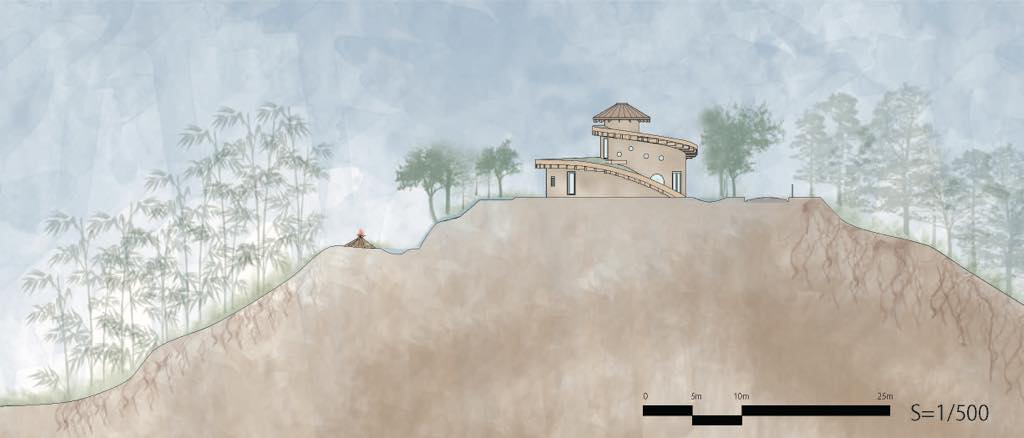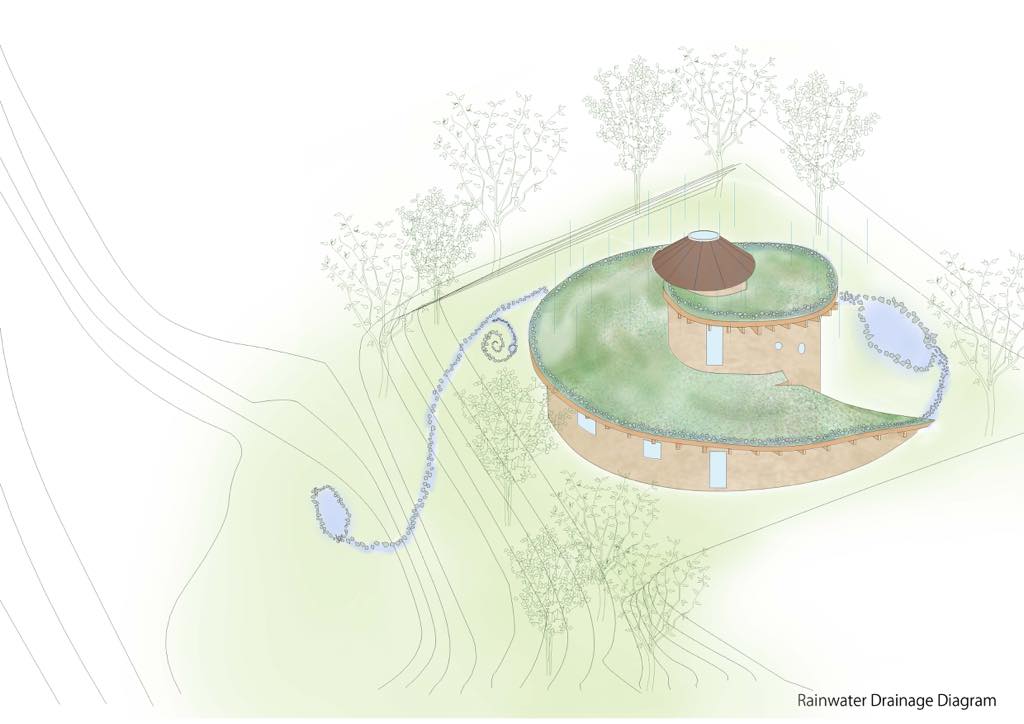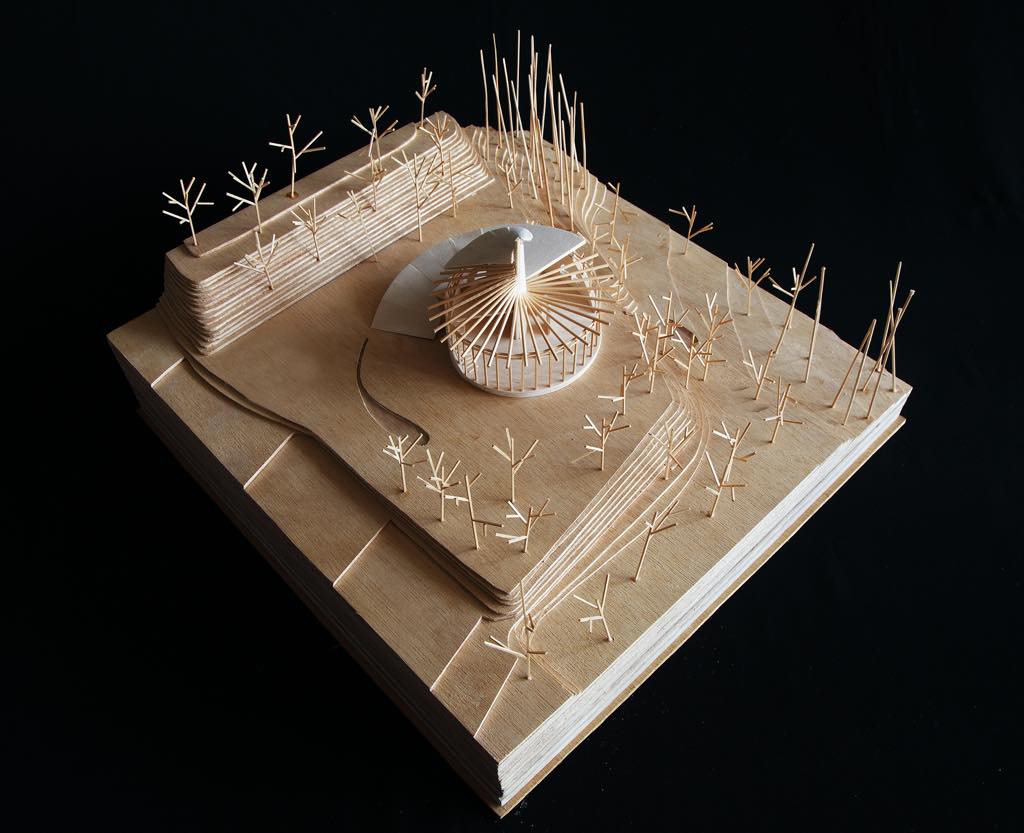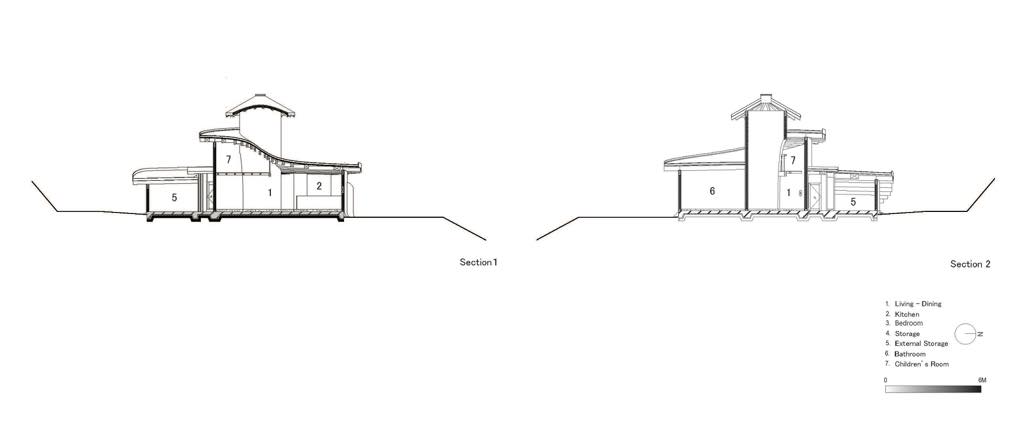SPIRAL GARDEN
CONCEPT
JAPANESE / ENGLISH
成長する土と木の家淡路島で計画したこの家は、敷地面積約1,000m2をもつ。広大な土地全体を対象に、家と庭を同時に考えた。夫婦とふたりの子供が住むための家で、「完成された家や庭はいらない。家族全員で、家族の成長と共に考えながらつくりこんでいける家のベースをつくってほしい」との要望があった。この問いはわれわれに根源的な住居のあり方を考えさせることになった。
設計期間3年以上と長い時間を費やしたが、要望と計画は、次第に余計なものがそぎ落とされシンプルになっていった。家族4人が集うためのより原始的な建築のあり方を探っていき、丸い一室空間の平面をもち、外部との連続性、求心性をもたせるために螺旋状のプランとし、寝室、収納、水回り以外はワンルームの空間を計画した。子供がまだ小さいが、大きくなって個室がほしいといったら、どこかの庭に子供たちが望む家を自分でつくらせるという両親の考えである。大らかな建主からは、計画を通して家や庭のさまざまな可能性に気づかされた。そして家の中心部には、機能をもたない内部の庭を計画した。大きな家具も置かない直径約2.4m、高さ7.5mの吹抜け空間である。家族が普段集う台所や食堂回りからは、見通せない「無のニハ」であり、この家、そして家庭の中心的な存在である。上部には直径600mmのトップライトを設けて、日中は空間内には光の軌跡が現れる。照明を一切設けず、夜間には闇が現れる。またトップライトは、開放すると上昇気流を生み出す風洞の役割も果たす。この家の中心の「無のニハ」は、時にひとりで瞑想する空間であり、友人たちが集えば音楽を奏でる空間であり、使い方が変化する余白の空間である。常時は使われないことも多く、しかし家族や集う人びとの心を惹きつける重要な存在である。
特異な形態の建築であるが、淡路島に残る昔ながらの民家の構法を継承しようと考え、在来木造を応用して、土を多用している。螺旋を描く木構造は、中心にある円筒の柱から放射状に梁を架け、内部空間で露わとなる。3次曲面の屋根形状であるため、部材はすべて大工による手刻みで行った。内壁は、敷地周辺で採れた竹小舞を下地として淡路島の土で仕上げ、外壁も土とモルタルによる掻き落とし仕上げである。床も三和土土間で仕上げた。内部仕上げの土は蓄熱と調湿において十分な効果をもつ。
屋根面は、大地から生態が連続しながら螺旋状に上昇する、建主が育てるスパイラルガーデンとして計画した。螺旋形状の屋根は、場所によって異なる方位と高さが得られるため、日照と湿度の状態に応じてさまざまな異なる種類の植物の生育環境をつくる。さらに屋根に降り注ぐ雨水は、計画するスウェールによって、一気に流れ落ちることなく徐々に流れ落ち、すべての生物たちを潤しながらため池に導かれる。溜池の水は夏場には住宅内に冷気を送り込む。
外部空間では、敷地全体に及ぶ建主と思考したさまざまな庭が計画されている。家と庭が共に価値をもつことを前提に考え、木と土による住処をつくり、光、風、水、緑といった自然の恩恵を感じとれる家族のためのフィールドをつくろうと考えた。竣工時には、ほぼ何もない状態であったが、成長する家と庭の物語はすでに始まっている。
The house where the earth and trees grow
The project is on a 1,000 m2 site on Awaji Island, Hyogo, Japan. To make use of the site to its’ maximum extent, the house and its’ landscape were planned at the same time. The client, a family of four, requested, “Instead of a finished house, we want a house which we can complete on our own; a house that grows along with the family.” The request prompts the office to re-think the ideal residence for the family.
Three years of design process has stripped away the excess while keeping the essentials intact. The office explored a more primitive architectural approach based on family gathering. It resulted in a spiral, continuous plan that are in contact with the exterior at all sides, with rooms such as storage and bedroom on its’ fringes. Extension for children’s bedroom in the future is also accommodated.
Various possibilities between the house and the garden emerged upon inspection of the plan.At the core of the house is an unassigned space, Niha, with diameter of about 2.4m and a height of 7.5m. From the kitchen and dining room where the family would gather, the Niha is hidden from sight. During the day sunlight seeps through the sky light atop the Niha, with a diameter of 600 mm. At night darkness sinks as there are no lights installed. When opened, the sky light also functions as a tunnel to which the wind ascends from the ground. As it is unassigned to a pre-defined function, the center of the house is free to be used for miscellaneous activities, be it meditation or gathering with friends. Its’ existence is significant in which it caters to the family’s life dynamics.
Its’ unconventional form conceals a nod to Awaji island’s local timber-constructed houses, clad in Earth. To support the roof, timber beams follow the spiral and ‘radiate’ from the central space, exposed in the interior. Every part of the timber construction were hand-carved by carpenters. Its’ interior wall was finished with Awaji Island’s Earth on top of interwoven lattice of Bamboo collected around the site. The outer wall is scraped with a finishing of soil and mortar, while the floor was finished with Sanwa Earth technique. The interior earth finishing are able to store heat and control humidity
The roof is planned as a spiral garden, in which the ground rises towards the sky. The spiral roof offers varying sunlight exposure, height and humidity, hence able to support plants with diverse growth requirements. When it rains, the roof garden is soaked while rainwater flows towards the pond. In the summer, incoming wind will be cooled by the pond before it enters the house. Throughout the garden, trees to be planted have been planned accordingly. It is hoped that by introducing natural phenomenon as inseparable parts of the house, the family would be one with nature; in the form of a house where the earth and trees grow, in which the house and the garden complements each other. When the house is complete, the story of the growing house and garden has only just begun.
The house where the earth and trees grow
The project is on a 1,000 m2 site on Awaji Island, Hyogo, Japan. To make use of the site to its’ maximum extent, the house and its’ landscape were planned at the same time. The client, a family of four, requested, “Instead of a finished house, we want a house which we can complete on our own; a house that grows along with the family.” The request prompts the office to re-think the ideal residence for the family.
Three years of design process has stripped away the excess while keeping the essentials intact. The office explored a more primitive architectural approach based on family gathering. It resulted in a spiral, continuous plan that are in contact with the exterior at all sides, with rooms such as storage and bedroom on its’ fringes. Extension for children’s bedroom in the future is also accommodated.
Various possibilities between the house and the garden emerged upon inspection of the plan.
At the core of the house is an unassigned space, Niha, with diameter of about 2.4m and a height of 7.5m. From the kitchen and dining room where the family would gather, the Niha is hidden from sight. During the day sunlight seeps through the sky light atop the Niha, with a diameter of 600 mm. At night darkness sinks as there are no lights installed. When opened, the sky light also functions as a tunnel to which the wind ascends from the ground. As it is unassigned to a pre-defined function, the center of the house is free to be used for miscellaneous activities, be it meditation or gathering with friends. Its’ existence is significant in which it caters to the family’s life dynamics.
Its’ unconventional form conceals a nod to Awaji island’s local timber-constructed houses, clad in Earth. To support the roof, timber beams follow the spiral and ‘radiate’ from the central space, exposed in the interior. Every part of the timber construction were hand-carved by carpenters. Its’ interior wall was finished with Awaji Island’s Earth on top of interwoven lattice of Bamboo collected around the site. The outer wall is scraped with a finishing of soil and mortar, while the floor was finished with Sanwa Earth technique. The interior earth finishing are able to store heat and control humidity
The roof is planned as a spiral garden, in which the ground rises towards the sky. The spiral roof offers varying sunlight exposure, height and humidity, hence able to support plants with diverse growth requirements. When it rains, the roof garden is soaked while rainwater flows towards the pond. In the summer, incoming wind will be cooled by the pond before it enters the house. Throughout the garden, trees to be planted have been planned accordingly. It is hoped that by introducing natural phenomenon as inseparable parts of the house, the family would be one with nature; in the form of a house where the earth and trees grow, in which the house and the garden complements each other. When the house is complete, the story of the growing house and garden has only just begun.
| LOCATION | Awaji City, Hyogo, Japan |
|---|---|
| CATEGORY | HOUSING |
| TYPE | Single-Family House |
| DATE | 2018.1 |
| STATUS | completed |
| SCALE | 101.85 m² |
| STRUCTURE | Timber |
| CLIENT | - |
| CONSTRUCTOR | ㈱雨松工務店 Amematsu Builders Ltd. |
| COLLABORATORS | Takuo Nagai (University of Shiga Prefecture) |
| PHOTO | kaori ichikawa |
| AWARD | ・木材活用 ・ARCHITECTURE, CONSTRUCTION & DESIGN AWARDS 2018 |
| PUBLICATIONS |
Jutaku Tokushu (no.387), Elle Decor Japan (no.157), MARU CA (no.197), MODERN GREEN HOMES Sanctuary (Issue 45), Dezeen, DesignBoom, Archdaily, Archello, Architizer, Architect Magazine, etc |
| NOTES | - |

